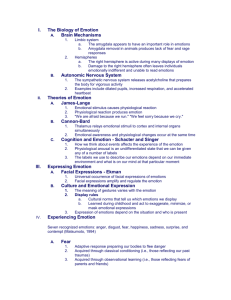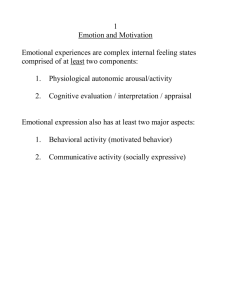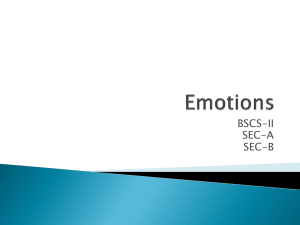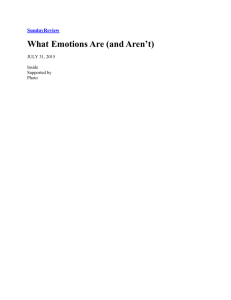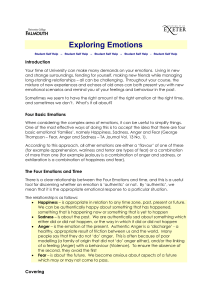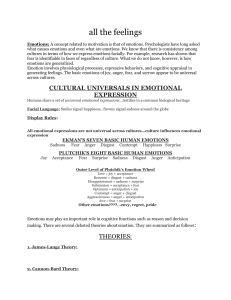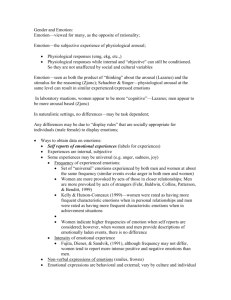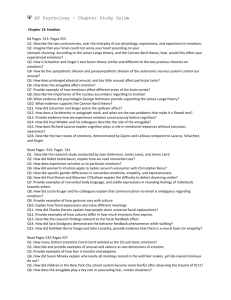emotions
advertisement
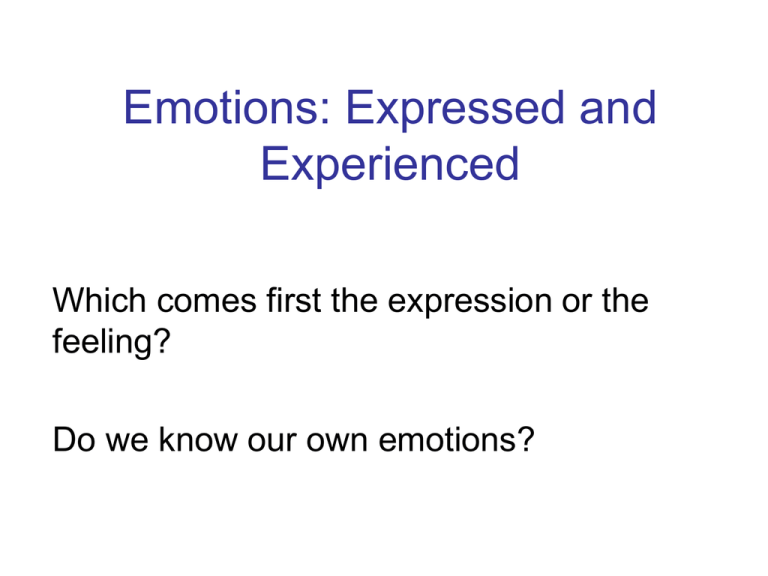
Emotions: Expressed and Experienced Which comes first the expression or the feeling? Do we know our own emotions? LOL! QuickT ime™ and a decompressor are needed to see this picture. Laughter Quic kT ime™ and a dec ompress or are needed to s ee this pi cture. • Is contagious • can provide relief from pain, alleviate stress and promote functioning of the immune system. • Can be used to promote solidarity among people -- as well as for exclusionary purposes. Physiology and Feeling? • We often take it as a given that we experience an emotion and then our bodies react to reflect that feeling. • But it can be bi-directional. • Hold the pencil in your teeth or with your lips and read comic strips James-Lange theory: • We feel sad because we cry, angry because our blood pressure rises, afraid because we tremble • The emotional experience is the consequence of a specific physiological reaction. – Support: Hold the pencil in your teeth or with your lips and read comic strips QuickTime™ and a decompressor are needed to see this picture. Cannon-Bard Theory • Stimulus simultaneously triggers activity in the ANS and emotional experience. – Blush and feel embarrassed at the same time 2 Factor Theory • Different emotions are merely different interpretations of a general pattern of bodily activity. • Your heart beats fast….so is it fear, anger, love, caffeine…. Love on a swinging bridge? • 1974 - Dutton and Aron • Experimental group = Young men crossing a long, narrow, suspension bridge that rocked & swayed 230 ft above a river. • Control group = Young men crossed a long, narrow, suspension bridge that rocked & swayed 230 ft above a river and “rested” for 10 minutes • Approached by an attractive female (researcher), asked to complete a survey and given her phone #. • Who called her more? Love on a swinging bridge? • 13 out of 20 called in the experimental group, while only 7 out of 23 called from the control group. • Fear and attraction exchangeable? • Supports the 2 factor theory. So which is correct? • Turns out that each theory has some support, but isn’t completely accurate. – We don’t just have general physiological response to emotion. -- certain combinations of physiological responses are related to certain emotions. – But we also aren’t perfectly sensitive to these combinations -- we misattribute our physiology. – The bodily reaction causes and is a consequence of the mentally feeling an emotion. WOW! Do we even know our own emotions? Do we know other people’s emotions!? demonstration • Try to accurately decode the motion being expressed here. – “I’m absolutely thrilled to be here” – “Gee thanks” – “Way to go dude” – “Real nice” demonstration • Nervousness, surprise, disgust, anger, sadness, fear, and happiness have been found in studies to be the easiest emotions to detect. Whereas love, fear, desire, jealousy, pride, disappointment and relief are much more difficult to detect. • Gender differences? • What does this mean? – the role of empathy in understanding others’ emotional reactions. http://www.kqed.org/quest/tele vision/emotions-revealed – Are expressions universal? • The 6: anger, disgust, surprise, fear, happiness, sadness Cultural Differences • While it seems universal to read the 6 major emotions; there are different expectations of how people will show them. • Awlad Ali Bedouins of Egypt’s western desert do not express feelings of loss or hurt in public; instead they show indifference or anger or assign blame. • Tahitian language lacks terms for sadness, longing and loneliness; instead they interpret these sensations as a type of sickness Lie to Me • Our attempts to obey our culture’s display rules are sometimes betrayed by incomplete control of facial muscles 15 Deceptive Expression • Humans are generally not that good at detecting when others are lying • Studies look at accuracy based on profession (100% = perfect accuracy, 50% = guessing) 16 Deceptive Expression • Polygraph –measures physiological changes associated with stress –high false positive rate • Blood flow in brain –some brain areas are more active when people lie than when they tell the truth 17 stop The Emotional Brain • Temporal lobe syndrome • Amygdala –appraisal –bilateral amygdala damage –no effect on recognition of happiness, sadness, & surprise –trouble recognizing anger, disgust, & fear • Nucleus accumbens 19 The Emotional Brain • Amygdala – make a rapid appraisal (pink route) – why? • Cortex – make a slow, thorough appraisal (green route) – why? 20 The Emotional Brain • Emotional regulation – typically to turn negative into positive – may sometimes need to “cheer down” • Reappraisal – thinking can change feeling – shown photo of woman crying at funeral amygdala became active – asked to reappraise and imagine woman is at wedding cortex became active and then amygdala deactivated 21 Emotional Communication • Emotional expression – emotional states influence the way we talk (intonation, inflection, loudness, & duration) – listeners can infer a speaker’s emotional state with better-than-chance accuracy – can also infer emotional states from how someone walks and facial expressions • Affective forecasting – not too good at predicting our emotional reactions to future events 22 Communicative Expression • Universality hypothesis – cross-cultural research supports this – congenitally blind persons make same expressions as others • The cause and effect of expression – feelings cause emotional expressions (muscles) – facial-feedback hypothesis – people with trouble experiencing emotions have trouble recognizing the emotions of others 23 Communicative Expression • Deceptive expression • Display rules –intensification –deintensification –masking –neutralizing 24 What Is Emotion? • Multidimensional scaling • Dimension of arousal • Dimension of valence (feeling) 25 Physiology of Emotion 26 Pg 208 in Blink • Subjects look at cartoons while holding a pen between their lips or teeth • Teeth found the cartoon much funnier • Ekman, Friesen and Levenson


